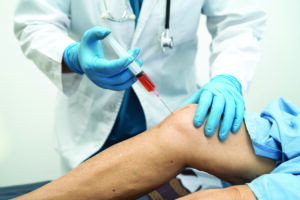
Organ and tissue loss through disease and injury motivates the development of therapies that can regenerate tissues and decrease reliance on transplantation. Regenerative medicine, an interdisciplinary field that applies engineering and life-science principles to promote regeneration, can potentially restore diseased and injured tissues and whole organs. Since its inception several decades ago, a number of regenerative medicine therapies, including those designed for wound healing and orthopedic applications, are slowly becoming commercially available.
Many feel that modern rehabilitation is now being catapulted into the future via this regenerative medicine. These treatments use different techniques to help the body heal its own tissues, to put it simply, ‘regenerate’. Regenerative rehabilitation is the amalgamation of concepts and techniques from rehabilitation and regenerative medicine, with the ultimate goal of repairing and healing degenerated, diseased or damaged tissue, and can help provide solutions for our growing aging population. Regenerative medicine is a relatively new field, but research proves its possibilities are almost endless.
Regenerative medicine has the potential to heal or replace tissues and organs damaged by age, disease, or trauma, as well as to normalize even congenital defects. Promising pre-clinical and clinical data support the possibility for treating chronic diseases, and for regenerative medicine to abet maladies occurring across a wide array of organ systems and contexts, including dermal wounds, cardiovascular diseases and traumas, certain cancer treatments, and more.
There are four types of regenerative therapy in Orthopedics in particular, now being used that show even greater promise for the future.
- Stem Cell Treatments: A regenerative therapy that uses a special cells to repair injuries. Stem cell therapy is widely used to treat back pain and helps regenerate tissues in the spinal discs. Stem cells are special cells that do not have a specific purpose in the body that can develop into a type of cell that serves a function.
When used in regenerative medicine, stem cells are collected from the patient’s own fat, blood, or bone marrow. They are then put into a medical machine called a centrifuge so the doctor can identify and separate the cells to find the right ones to use for the regenerative therapy treatment. The cells are then injected into the part of the body that needs to be repaired. For instance, to repair spinal discs, stem cells would be injected directly into the damaged disc. The cells will then develop into healthy spinal disc cells and repair the disc.
- Cartilage Regeneration: This regenerative therapy helps people with musculoskeletal conditions. It is aimed at healing damaged cartilage. Cartilage does not heal well on its own because it does not contain enough blood vessels and doesn’t always have a constant blood supply. There are several techniques used for cartilage regeneration. According to research findings, cartilage regeneration is ideal for active people under 55 years old.
- Platelet-Rich Plasma (PRP): This therapy is based on the hypothesis that the blood’s platelets and plasma can heal and repair injuries. PRP treatments are usually used in sports medicine to repair tendon injuries. To make platelet-rich plasma, blood is drawn from the patient and then processed to create a concentrated solution that contains more platelets and plasma than regular blood. A centrifuge is used to create this solution. PRP is either injected into the injured tendon or applied during surgery.
- Prolotherapy: This regenerative therapy treats injured joints and connective tissues. It is often used to treat arthritis, whiplash, and degenerative disc disease. It can be used on the back, neck, shoulders, hip, hands, and knees. In prolotherapy, a doctor injects a watery solution containing substances like saline and dextrose into the injured area. These injections usually contain a numbing agent like lidocaine as well.
The injection irritates the injury site, triggering the body’s healing response. As a result, the body grows new connective fibers to repair the damaged tissue. This relieves the pain associated with the damaged connective tissue. Several treatments may be done to stimulate more new tissue growth.
Regenerative therapy innovation can benefit the society with its potential to address a variety of incurable diseases, solve the problem of organ shortage and boost the economy by reducing treatment costs and promoting health.
Surgical options for those dealing with painful knee issues range from arthroscopic knee surgery to total knee joint replacement. Recent research has shown that some of the most popular arthroscopic surgeries, such as meniscectomy, provide little benefit to the patient. Knee replacement is traumatic and may carry risks of chronic pain and toxic wear particles entering the bloodstream. Surgical risks aside, all surgeries require months of rehab to regain strength and mobility. Most knee surgeries also accelerate the cascade of degeneration that leads to Osteoarthritis.
Despite enormous benefits, the problems associated with the development of regenerative medicine must be confronted before further research is carried out. Cautious approach should be taken to ensure ethical codes are not breached. There’s also the need to establish a global legal framework to prevent the risks of companies and individuals taking advantage of this innovation.
The fact that most of the research funding comes from the private sector controls the direction of the research in this sphere. The risk of regenerative medicine being commercialized for the wrong purposes is a possibility. Without a consistent legal framework and strict regulations, human greed for profits and desire for longevity can lead to inappropriate use of regenerative medicine’s offerings.
To conclude, I would like to let our readers decide if they are ready to embrace regenerative therapies or wait for now. Nevertheless, the field of medicine is very excited about the possibilities this new therapy brings to the fore. We have a lot to gain through furthering stem cell research, but medical breakthroughs should only be fundamentally about saving, not destroying human life.
- Move Bawa Move!! - 15 March2025
- The Healing Power Of ‘Shinrin-Yoku’ (Forest Bathing) - 28 December2024
- The Incomparable Health Benefits Of Plant-Based Diet - 30 November2024
